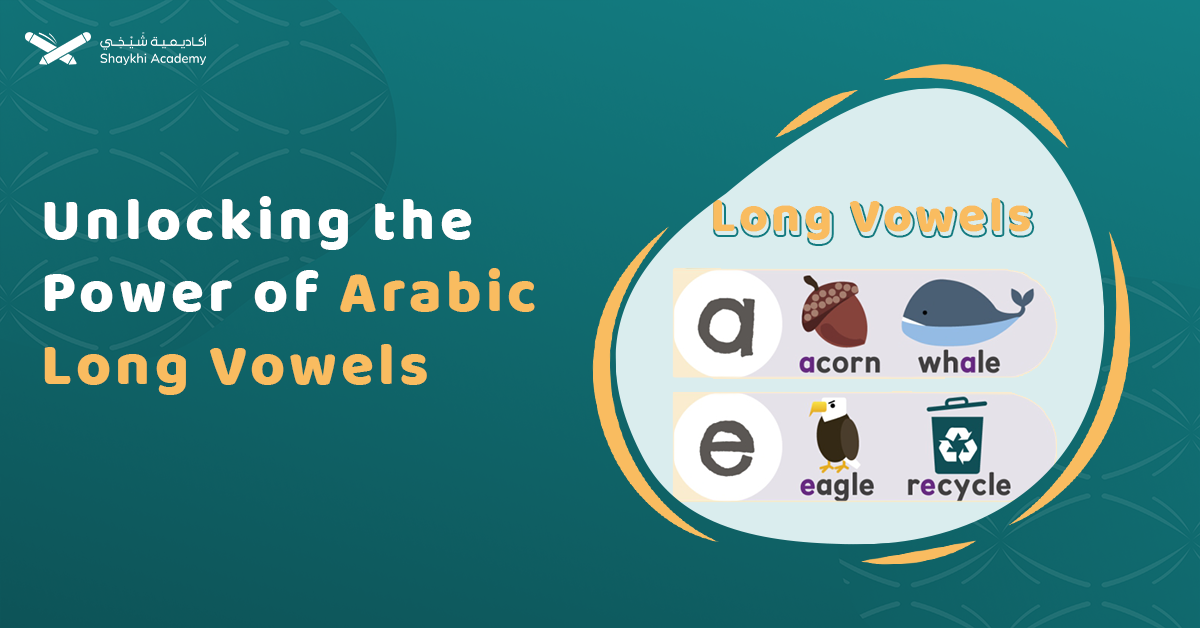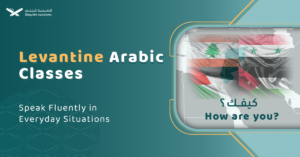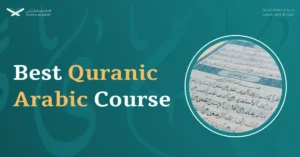Arabic long vowels, or Mudud, are elongated sounds formed by Alif, Waw, and Yaa when preceded by Fatha, Dhamma, or Kasra, respectively. Unlike short vowels (Harakat), they form integral parts of words, extending pronunciation for clarity. For instance, in (قَالَ), the Alif creates a prolonged “aa” sound. Recognizing these vowels ensures accurate reading and Quranic recitation. Learn more with tailored Arabic and Tajweed lessons at Shaykhi Academy!
Do you want more details? Are you new to learning Arabic and the Quran? Are you curious about Arabic long vowels and how to pronounce and distinguish them in different texts?
This guide offers practical tips for beginners on understanding long vowels in Arabic and differentiating them from short vowels. It also supports Quranic learners by providing tips on reading long vowels, illustrated with examples. Additionally, the guide highlights common mistakes to avoid early on, making it valuable for parents and tutors guiding beginners.
Keep reading for more!
What Are Arabic Long Vowels?
Arabic long vowels are the prolonged sounds in Arabic words, known as Mudud (plural of Madd). They are represented by three letters:
1. Alif: When Alif has no diacritic over it and is preceded by Fatha, it becomes a long-voweled letter. For example, (وَالِد) – “parent.” Here, Alif has no diacritic and is preceded by Fatha over the letter Waw, making it Madd Alif, which is pronounced longer than other normal letters.
2. Yaa’: When Yaa’ has no diacritic over it and is preceded by Kasrah, it becomes a long-voweled letter. For example, (فَقِير) – “needy.” Here, Yaa’ has no diacritic and is preceded by Kasrah under the letter Kaaf, making it Madd Yaa, which is extended longer than other normal letters.
3. Waw: When Waw has no diacritic over it and is preceded by Dhamma, it becomes a long-voweled letter. For example, (أَعُوذ) – “I seek refuge.” Here, Waw has no diacritic and is preceded by Dhamma over the letter Ain, making it Madd Waw, which is also extended longer than other normal letters.
Thus, understanding long vowels in Arabic helps learners pronounce Arabic words correctly and accurately.
Recognizing Arabic Long Vowels When Reading:
Since Arabic long vowels can serve as both vowels and normal letters, they must meet two rules to be considered long vowels. Otherwise, they are treated as normal letters:
1. No Diacritic Over or Under:
If Alif, Yaa, or Waw has a Fatha, Kasra, Dhamma, or Sukun over or under it, then it is a normal letter, not a long vowel.
2. A Suitable Diacritic Before:
- For Madd Alif, it must have a Fatha on the letter before it.
- For Madd Yaa, it must have a Kasra under the letter before it.
- For Madd Waw, it must have a Dhamma on the letter before it. If these conditions are not met, they are normal letters, not long vowels.
For example, in the following word (بَيْت) “home,” the Yaa does not serve as a long vowel because it is not preceded by Kasra.
By recognizing these two conditions, learners can easily identify long vowels in Arabic sentences.
How Do Arabic Long Vowels Differ from Short Vowels?
Long vowels in Arabic (Madd Alif, Madd Yaa’, and Madd Waw) are the extended sounds of short vowels (Fatha, Kasra, and Dhamma). There are several differences between the two cases as follows:
1. Arabic Names for Each Type:
Short vowels in Arabic are known as Harakat (diacritics), while long vowels are referred to as Mudud (prolonged letters).
2. Time Consumed for Pronunciation:
Long vowels are extended sounds of short vowels. For example, Fatha can be extended to Madd Alif, Kasra to Madd Yaa, and Dhamma to Madd Waw. As a result, the pronunciation of long vowels takes more time than short vowels.
3. Role in Word Structure:
Long vowels serve as fundamental letters in Arabic words, while short vowels act as guiding aids for proper pronunciation.
4. Appearance in Arabic Texts:
Long vowels are essential components of Arabic words and must be present. In contrast, short vowels may or may not appear in texts depending on the context, type of content, and target audience.
5. History in Arabic Calligraphy:
Since long vowels are integral parts of words, they have existed in Arabic calligraphy from its early times. On the other hand, short vowels were later innovations by Muslim scholars to help non-native Arabs pronounce the Quran correctly and preserve the Arabic linguistic heritage.
In Brief, long and short vowels are distinct in the Arabic language, sharing a foundation in phonetics but differing in their names, history, necessity, and roles.
Tips for Pronouncing Arabic Long Vowels in Quranic Texts
Arabic long vowels have unique shapes and rules in Quranic texts compared to other Arabic writings. Below are some tips to help you understand and properly pronounce Arabic long vowels in the Quran:
1. Different Shapes and Sizes:
Long vowels in the Quran may appear as small Alif, Yaa, or Waw embedded within words or as normal letters. Note the different shapes in the following Quranic verse, with the intended words bold and underlined:
“إِنَّآ أَوۡحَيۡنَآ إِلَيۡكَ كَمَآ أَوۡحَيۡنَآ إِلَىٰ نُوحٖ وَٱلنَّبِيِّـۧنَ مِنۢ بَعۡدِهِۦۚ… وَءَاتَيۡنَا دَاوُۥدَ زَبُورٗا”
[Indeed, We have sent revelation to you ˹O Prophet˺ as We sent revelation to Noah and the prophets after him. … And to David We gave the Psalms.] (4:163)
In this verse:
- The first underlined word contains Madd Alif in its small shape, which has the same pronunciation and rules as the normal Madd Alif.
- The second underlined word includes a small Madd Yaa.
- The third underlined word features a small Madd Waw, which follows the normal Waw marked with a Dhamma, indicating the presence of the Madd Waw.
Additionally, normal shapes of long vowels appear in this verse, such as the Madd Alif in (أَوۡحَيۡنَآ) [We revealed].
2. Long Vowel Application Rule:
In Quranic recitation, a Madd letter is not extended if it occurs at the end of a word followed by a non-voweled letter in the next word. This is because pronouncing both simultaneously can hinder fluency. In such cases, it is pronounced as a short vowel rather than a long one.
3. Different Times of Extension:
The Quranic rules for long vowels, addressed in Tajweed science, vary the extension time based on specific conditions:
- If a Madd letter has a wave over it, it is extended for 4–6 counts.
- Otherwise, it is extended for the normal duration of 2 counts.
For example, note the wave over the Madd Alif in (إِنَّآ), indicating an extended pronunciation in the sentence.
To better understand the application of long vowel rules in the Quran, listen to recitations by authentic reciters such as Al-Husary and Abdulbaset while following along in the Mushaf. This will help you correlate theory with practice. Also, you can start a Tajweed class tailored for beginners with Shaykhi Academy for better recitation.
Examples of Words with Arabic Long Vowels
To simplify the theoretical rules of long vowels (mudud), a table is provided below with examples for each letter, supported by transliteration and translation:
| Madd alif examples | Madd yaa’ examples | Madd waw examples |
| (قَالَ) – /qaal/ – he said | (لِلْمُصَلِّين) – /lilmusaleen/ – for prayers | (فَاعِلُون) – /fa’iluun/ – performersThe word has both madd alif and waw. |
| (سَلَام) – /salaam/ – peace | (الَّذِين) – /al-ladheen/ – those who | (خَذُوا) – /khudhuu/ – take |
Common Mistakes When Learning Arabic Long Vowels
Beginners and non-native Arabs often make certain mistakes while learning Arabic long vowels. These common mistakes include:
- Dropping the long vowel in writing or pronunciation
- Shortening the time of extension for the long vowel based on its type
- Elongating the sound time of a long vowel beyond its correct duration
By exposing learners to these common mistakes before practice, it will be easier for them to minimize errors.
Learn Arabic And Tajweed Rules With Native Arab Tutors At Shaykhi Academy!
Shaykhi Academy offers a selection of Arabic courses and Tajweed classes tailored for beginners and non-native Arabs, aimed at helping them improve their Quranic recitation and Arabic proficiency. These courses include:
Subscribe now and start your free trial!

Conclusion
Learning Arabic can be challenging for non-native speakers due to its unique grammatical system. Studying Arabic long vowels is one of the early steps in mastering the language and should be built on a solid foundation with consistent practice. Keep your motivation and good intentions strong to facilitate your learning journey. May Allah Almighty ease your affairs!

















































